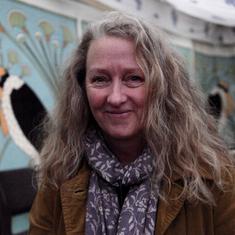The 2022 Booker Longlist boasted variety in the range of books it offered. From who writes, who publishes, what is written, how much is written to how it’s written. A patient glance through the list tickles readers of varying tastes, interests and expectations from what a book delivers. Among them, Maddie Mortimer’s Maps of Our Spectacular Bodies, that stands out for its very interesting format, and a story that sketches human bodies in myriad transitions.
Lia is sick. At the very outset, the readers are informed of the cancer that has taken control of her body yet again. But it’s not Lia who says it out loud. It is the disembodied, shape-shifting voice of the illness, cancer, which speaks in bold texts throughout the book. Written in verse form, the book defies conventional mode of writing a novel by making it a visual experience in the very pages.
Lia’s steadfast relation with her husband is shown in an image of dips and swells of words when he reassures here that, “We’ve done it before and we’ll do it again.” The ‘it’ being the cancer that has returned with horror of past memories to wreak havoc in her present. And then we find her young daughter Iris, who’s confronting the word cancer by drawing it out in her notebook at school when asked to speak on their parents’ job. In the middle of this family dealing with a medical catastrophe breathing down their necks, the reader find themselves navigating a story that measures word, and maps them through bodies onto visual spectacles like a bird, trickling drops of water, waves, connecting dots, released sighs or concentric circles.
Cancer, body, family, future
Despite the control the cancer has taken over her present body, Lia has a past she can’t escape. A past where she was only a girl living in a small English village with Father Peter (her father), and her mother, Anne. Her body belonged to the Christ, the God, was what she heard growing up but it all began changing when 16-year old Mathew showed up at their doorstep. We follow Lia dipping in and out of her past throughout the book in the same twist of language and narration as her past unfurls and weaves into the present. But the question that Lia, her family, and readers have is – Will her body beat cancer again? Will Lia have a future? Is the family going to really ‘do it again’? And this for the most part, besides the turns Lia’s childhood takes, keeps the reader engrossed, captivated and wholly entranced.
The story as the title implies is a search for a destination humans take through the maps their bodies provide. Lia does that but so does her daughter Iris when she burns her hand with a cigarette to be a part of a peer group, so does Harry when he imagines making love to his student and so do various characters in the book in their own specific ways. Somewhere, the binary that cultures have built between the body and the social begins falling through and coalescing with one another.
In fact, Mortimer’s depiction of bodies as much a part of the external and the social as much a part of the interiority makes the reader believe in the character of the speaking-cancer. The cancer doesn’t reduce to Lia’s imagination but acquires the role of a living protagonist (or antagonist here) with its own social locus.
Sections of the book are dedicated to particular bodily activity, or processes that may strike as utterly taxing and suffocating to be contained in a body, to be limited in its scope. The section on ‘gloaming’ where there was ‘voice tearing’, ‘tongue flapping like a dead wet fish’, and voice croaking read like two hands tightening the grip over Lia’s neck almost packing her off to death. And that’s the visual dystopia the author conjures by portraying the transitions in her characters’ bodies viscerally through words and an artistic narrative structure.
A promise to language
But the story also had its moments of being funny when it had to release the continuous tension within the domestic space of the household. The twins from Lia’s childhood; Iris’ ‘deadly serious’ confession of the boy who likes soleros; Lia, Harry and Iris’ passing jokes on the awaiting ballet performance of Connie (Lia’s friend) are some of the many moments where strings holding the plots through tragedy are released. Here, the story takes shape through both laughter and tears, anger and forgiveness, failure and achievement, beauty and defilement.
Above all, Mortimer’s book is a promise to language, to reproduce it through a whirlpool, a spinning motion with swells and lapses like human bodies. It’s an art made of words. It’s a novel you will either fly through or spend time being moved by its structure, and the meanings it lends to a story of a woman, a family seeking answers for a destination through their bodies. The book, indeed, was a sharp contender for the Prize despite the jury’s reluctance to carry it further.

Maps of Our Spectacular Bodies, Maddie Mortimer, Picador.










